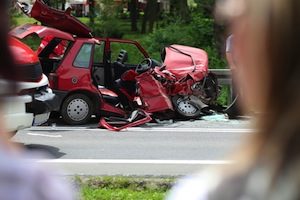 Sometimes, injuries received in a car accident are worse than they should have been as a result of the car’s structure or other safety systems such as the seatbelts and airbags because these systems did not sufficiently protect you in the accident. This is usually referred to as a crashworthiness case.Crashworthiness is the ability of a vehicle to prevent injuries to its occupants in the event of a foreseeable collision. Crashworthiness deals with the second collision which results from the occupant impact the interior of the vehicle. If a vehicle is crashworthy, the vehicle’s design will distribute potentially injurious forces over as large a distance and period of time as possible.
Sometimes, injuries received in a car accident are worse than they should have been as a result of the car’s structure or other safety systems such as the seatbelts and airbags because these systems did not sufficiently protect you in the accident. This is usually referred to as a crashworthiness case.Crashworthiness is the ability of a vehicle to prevent injuries to its occupants in the event of a foreseeable collision. Crashworthiness deals with the second collision which results from the occupant impact the interior of the vehicle. If a vehicle is crashworthy, the vehicle’s design will distribute potentially injurious forces over as large a distance and period of time as possible.
If a vehicle is not crashworthy, catastrophic injuries or death may be involved in these types of cases. The automotive industry has promoted the use of seat belts and the implementation of airbags. These are extremely important safety devices. However, we as consumers also expect these safety devices to protect us in an accident. Unfortunately, these devices sometimes fail to operate properly, leaving the victim with massive injuries or dead. Wolff Ardis, P.C. has over 60 combined years of litigation experience dealing with these types of claims including:
- Defective seat belt systems
- Defective airbag systems, both front and side airbags
- Defective roofs which crush down on the victims during a rollover accident
- Defective fuel tank systems which causes fire
- Defective seats which collapse during an accident
- Defective doors and door latches which allow a door to open during an accident
- Defective glass in the windows which permit a victim to be ejecting from the vehicle during an accident
In a crashworthiness lawsuit, the cause of the accident is usually not considered. The premise behind a crashworthiness case is: although the defect in the design or manufacture of the vehicle and/or component was not the cause of the accident, the defect caused (or made worse) the injuries sustained. Consider, for example: an automobile hits the side of an SUV at a very low speed, the SUV rolls over, the side window glass breaks, and the driver’s arm goes out the window opening and is crushed between the vehicle and the pavement. The automobile caused the accident, but the injuries were caused by the unstable SUV which easily rolled over and the side window glass which shattered in the accident.
The question to be answered in a crashworthiness case is: Did the manufacturer design the vehicle and/or its components so that they were safe in a reasonably foreseeable accident?
Some common crashworthiness scenarios include:
– Design defects, where an injury occurs because of an unsafe design
– Manufacturing defects, where an injury occurs because of a flaw in the manufacturing process
– Failure to warn, where a manufacturer fails to warn occupants of a known danger in the vehicle or component’s design or manufacture.
In order to recover on a motor vehicle crashworthiness claim, you will need to show:
– a defective design caused an injury
– a safer alternative design was available
– a safer design could have lessened or prevented the injuries
– a safer design could have and should have been used
For additional information regarding a crashworthiness case and the process involved in pursuing a crashworthiness case, please contact our office by calling 901-763-3336 or online by clicking here.
Sometimes, injuries received in a car accident are worse than they should have been as a result of the car’s structure or other safety systems such as the seatbelts and airbags because these systems did not sufficiently protect you in the accident. This is usually referred to as a crashworthiness case.







